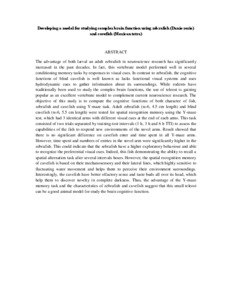Citation
Ahmad, Hafandi and Ahmad Zaki, Nabila Irqin and Ahmad Annuar, Azlina and Mohd Daud, Hassan
(2015)
Developing a model for studying complex brain function using zebrafish (Danio rerio) and cavefish (Mexican tetra).
In: 26th Annual Scientific Meeting of Malaysian Society of Neurosciences (MSN 2015), 5-7 June 2015, WEIL Hotel, Ipoh, Perak. (p. 38).
Abstract
The advantage of both larval an adult zebrafish in neuroscience research has significantly increased in the past decades. In fact, this vertebrate model performed well in several conditioning memory tasks by responses to visual cues. In contrast to zebrafish, the cognitive functions of blind cavefish is well known as lacks functional visual systems and uses hydrodynamic cues to gather information about its surroundings. While rodents have traditionally been used to study the complex brain functions, the use of teleost is gaining popular as an excellent vertebrate model to complement current neuroscience research. The objective of this study is to compare the cognitive functions of both character of fish, zebrafish and cavefish using Y-maze task. Adult zebrafish (n=6, 4.5 cm length) and blind cavefish (n=6, 5.5 cm length) were tested for spatial recognition memory using the Y-maze test, which had 3 identical arms with different visual cues at the end of each arms. This task consisted of two trials separated by training-test intervals (1 h, 3 h and 6 h TTI) to assess the capabilities of the fish to respond new environments of the novel arms. Result showed that there is no significant difference on cavefish enter and time spent in all Y-maze arms. However, time spent and numbers of entries in the novel arm were significantly higher in the zebrafish. This could indicate that the zebrafish have a higher exploratory behaviour and able to recognize the preferential visual cues. Indeed, this fish demonstrating the ability to recall a spatial alternation task after several intervals hours. However, the spatial recognition memory of cavefish is based on their mechanosensory and their lateral lines, which highly sensitive to fluctuating water movement and helps them to perceive their environment surroundings. Interestingly, the cavefish have better olfactory sense and taste buds all over its head, which help them to discover novelty in complete darkness. Thus, the advantage of the Y-maze memory task and the characteristics of zebrafish and cavefish suggest that this small teleost can be a good animal model for study the brain cognitive function.
Download File
![[img]](http://psasir.upm.edu.my/75601/1.hassmallThumbnailVersion/Developing%20a%20model%20for%20studying%20complex%20brain%20function%20using%20zebrafish%20%28Danio%20rerio%29%20and%20cavefish%20%28Mexican%20tetra%29.pdf)  Preview |
|
Text (Abstract)
Developing a model for studying complex brain function using zebrafish (Danio rerio) and cavefish (Mexican tetra).pdf
Download (37kB)
| Preview
|
|
Additional Metadata
Actions (login required)
 |
View Item |

